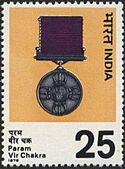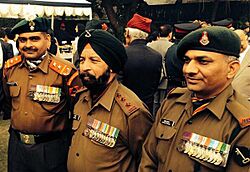Param Vir Chakra facts for kids
Quick facts for kids Param Vir Chakra |
|
|---|---|
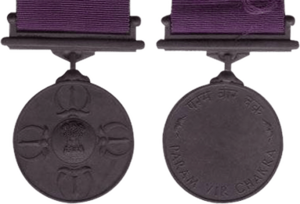 Param Vir Chakra and its ribbon
|
|
| Country | |
| Type | Military award |
| Status | Active |
| Post-nominals | PVC |
| Statistics | |
| Established | 26 January 1950 |
| Precedence | |
| Next (higher) | |
| Equivalent | |
| Next (lower) | |
The Param Vir Chakra (PVC) is India's highest award for bravery in the military. It is given to soldiers, sailors, and air force personnel who show amazing courage during wartime. The name "Param Vir Chakra" means "Wheel of Supreme Bravery". It is awarded for "most noticeable bravery when facing the enemy".
As of early 2018, this medal has been given 21 times. Out of these, 14 were given after the person had died (posthumously). Most of these awards (16) were for actions during conflicts between India and Pakistan. Twenty of the recipients were from the Indian Army, and one was from the Indian Air Force. Major Somnath Sharma was the very first person to receive this honor. Many Indian states and the central government also give money and rewards to the PVC recipients or their families.
India's awards for bravery today have a long history. They started when the East India Company ruled India. The first official award was created in 1834. After India became independent, new awards were made on January 26, 1950. These new awards counted for actions that happened from August 15, 1947. The Param Vir Chakra is similar to the Victoria Cross in the United Kingdom and the Medal of Honor in the United States.
Contents
How the Param Vir Chakra Began
The story of India's bravery awards goes back to the time of the East India Company. Indian officers first received gold medals for bravery in 1795. The first person to get one was Subedar Abdul Kader. In 1834, the Indian Order of Merit was started. This award was very important to Indians until the Victoria Cross (VC) became available to them in 1911. The VC was the highest bravery award in the British Empire.
During the First World War, the British Indian Army expanded its award system. This system continued through the Second World War. After India became independent in 1947, the British awards stopped being used.
India's first Prime Minister, Jawaharlal Nehru, wanted to create new bravery awards. This was especially important because of the conflict happening in Jammu and Kashmir in 1947. Leaders felt it was not right to give British honors to soldiers fighting against each other. So, in June 1948, they decided to create three new Indian awards for bravery: the Param Vir Chakra (PVC), the Maha Vir Chakra (MVC), and the Vir Chakra (VrC). The MVC and VrC are the second and third highest awards for bravery during wartime.
Nehru asked Major General Hira Lal Atal to make the PVC happen. Major General Atal then asked Savitri Khanolkar to design the medal. Interestingly, the first PVC was given to Major Somnath Sharma, who was related to Khanolkar's daughter.
India was still a "dominion" of the United Kingdom at that time. This meant the awards needed approval from the British King. However, getting the King's approval was difficult because India and Pakistan were fighting. So, the awards were not officially started right away.
On January 26, 1950, the PVC was officially created by Rajendra Prasad, who was the first President of India. It was decided that the award would count for brave actions that happened from August 15, 1947. If someone received the PVC more than once, they would get a special "bar" on their medal ribbon. This bar would have a small replica of the vajra, which is the weapon of Indra, the god of heaven. As of early 2018, no one has received a second PVC. People who receive the PVC can use "PVC" after their name.
What the Medal Looks Like
The Param Vir Chakra medal is a round bronze disc. It is about 35 millimeters (1.375 inches) wide. On the front, it has the National Emblem of India in the middle. Around the emblem, there are four copies of the vajra. The vajra is the weapon of Indra, an ancient Indian god. This design reminds people of a story where a wise man named Rishi Dadhichi gave his bones to the gods to make the vajra. This helped them defeat a demon.
The medal hangs from a straight bar. On the back, it says "Param Vir Chakra" in both Hindi and English. There are two lotus flowers between the words. A purple ribbon, 32 millimeters (1.25 inches) long, is used to wear the medal.
Brave Recipients
The Param Vir Chakra has been awarded 21 times. Fourteen of these awards were given after the person had died. Sixteen of the awards were for actions during conflicts between India and Pakistan. Out of the 21 recipients, 20 were from the Indian Army, and one was from the Indian Air Force.
The The Grenadiers regiment has received the most Param Vir Chakras, with three awards. The various Gorkha Rifle regiments have also received three awards in total.
As of early 2018, Flying Officer Nirmal Jit Singh Sekhon is the only Indian Air Force officer to have received the Param Vir Chakra. He was awarded it after he died in 1971. The only living recipients of the award are Subedar Major Bana Singh, Subedar Sanjay Kumar, and Subedar Yogendra Singh Yadav.
indicates that the Param Vir Chakra was awarded posthumously.
| Bust of recipient | Name | Rank | Unit | Date of action | Conflict | Place of action | Refs. |
|---|---|---|---|---|---|---|---|
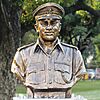 |
Somnath Sharma | Major | Kumaon Regiment | 3 November 1947* | Battle of Badgam | Badgam, Jammu and Kashmir, India | |
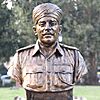 |
Jadunath Singh | Naik | Rajput Regiment | 6 February 1948* | Indo-Pakistani War of 1947 | Naushera, Jammu and Kashmir, India | |
 |
Rama Raghoba Rane | Second Lieutenant | Bombay Sappers | 8 April 1948 | Indo-Pakistani War of 1947 | Naushera, Jammu and Kashmir, India | |
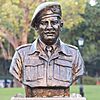 |
Piru Singh | Company Havildar Major | Rajputana Rifles | 17 July 1948* | Indo-Pakistani War of 1947 | Tithwal, Jammu and Kashmir, India | |
 |
Karam Singh | Lance Naik | Sikh Regiment | 13 October 1948 | Indo-Pakistani War of 1947 | Tithwal, Jammu and Kashmir, India | |
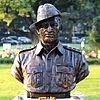 |
Gurbachan Singh Salaria | Captain | 1 Gorkha Rifles | 5 December 1961* | Congo Crisis | Élisabethville, Katanga, Congo | |
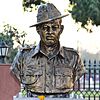 |
Dhan Singh Thapa | Major | 8 Gorkha Rifles | 20 October 1962 | Sino-Indian War | Ladakh, Jammu and Kashmir, India | |
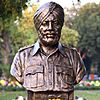 |
Joginder Singh | Subedar | Sikh Regiment | 23 October 1962* | Sino-Indian War | Tongpen La, North-East Frontier Agency, India | |
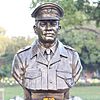 |
Shaitan Singh | Major | Kumaon Regiment | 18 November 1962* | Sino-Indian War | Rezang La, Jammu and Kashmir, India | |
 |
Abdul Hamid | Company Quarter Master Havildar | The Grenadiers | 10 September 1965* | Battle of Asal Uttar | Khemkaran, India | |
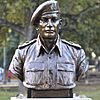 |
Ardeshir Tarapore | Lieutenant Colonel | Poona Horse | 11 September 1965* | Battle of Chawinda | Phillora, Sialkot, Pakistan | |
 |
Albert Ekka | Lance Naik | Brigade of the Guards | 3 December 1971* | Battle of Hilli | Gangasagar, Agartala, India | |
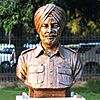 |
Nirmal Jit Singh Sekhon | Flying Officer | No. 18 Squadron IAF | 14 December 1971* | Indo-Pakistani War of 1971 | Srinagar, Jammu and Kashmir, India | |
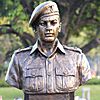 |
Arun Khetarpal | Second Lieutenant | Poona Horse | 16 December 1971* | Battle of Basantar | Barapind-Jarpal, Shakargarh, Pakistan | |
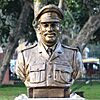 |
Hoshiar Singh Dahiya | Major | The Grenadiers | 17 December 1971 | Battle of Basantar | Basantar River, Shakargarh, Pakistan | |
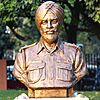 |
Bana Singh | Naib Subedar | Jammu and Kashmir Light Infantry | 23 May 1987 | Operation
Meghdoot |
Siachen Glacier, Jammu and Kashmir, India | |
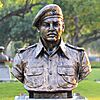 |
Ramaswamy Parameshwaran | Major | Mahar Regiment | 25 November 1987* | Operation Pawan | Sri Lanka | |
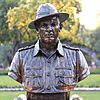 |
Manoj Kumar Pandey | Lieutenant | 11 Gorkha Rifles | 3 July 1999* | Operation Vijay | Khaluber /Juber Top, Jammu and Kashmir, India | |
 |
Yogendra Singh Yadav | Grenadier | The Grenadiers | 4 July 1999 | Operation Vijay | Tiger Hill, Jammu and Kashmir, India | |
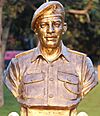 |
Sanjay Kumar | Rifleman | Jammu and Kashmir Rifles | 5 July 1999 | Operation Vijay | Kargil, Jammu and Kashmir, India | |
 |
Vikram Batra | Captain | Jammu and Kashmir Rifles | 7 July 1999* | Operation Vijay | Kargil, Jammu and Kashmir, India |
Rewards for Bravery
The Param Vir Chakra also comes with a cash allowance for those who are not high-ranking officers. Sometimes, there is also a special cash award. If a recipient dies, their spouse receives the pension until they die or remarry. If the recipient was unmarried and died, their parents receive the allowance.
A monthly payment of ₹20,000 is given to the awardee along with their regular salary. This award money and pension are not taxed. Also, different government departments give various financial awards to PVC recipients.
It is a tradition in the Indian Army that everyone, no matter their rank, salutes a PVC recipient when they are in ceremonial uniform. This shows great respect for their bravery.
State Government Allowances
Many Indian states give their own special pension rewards. These amounts are often much higher than the central government's payment.
| Cash amount | States awarding |
|---|---|
| ₹20 million (US$340,000) | Haryana |
| ₹10 million (US$170,000) | Telangana |
| ₹3 million (US$51,000) | Punjab |
| ₹2.5 million (US$43,000) | |
| ₹2 million (US$34,000) | |
| ₹1.5 million (US$26,000) | |
| ₹1 million (US$17,000) | |
| ₹22,500 (US$380) |
Memorials and Tributes
There are several places that honor the Param Vir Chakra recipients:
- In 2009, the Balidan Stambh war memorial in Jammu honored nine PVC awardees. Their names are carved on pillars and displayed near an eternal flame.
- In September 2014, a memorial for PVC recipients was built at Marina Park, Port Blair, in the Andaman and Nicobar Islands.
- In May 2017, a campaign called "Vidya Veerta Abhiyan" was started. It aims to build "walls of valor" in a thousand schools and colleges across India. These walls are about 15 by 20 feet and show all 21 PVC recipients with information about them. Students and teachers help contribute to these walls.
- In 2019, bronze statues of all 21 recipients were placed in the Param Yodha Sthal. This area is part of the National War Memorial in New Delhi. It has signs explaining the brave acts of these heroes.
- On January 23, 2023, the Indian government named 21 large islands in the Andaman Islands after the 21 Param Vir Chakra recipients. This was done to honor their incredible bravery.
See also
- List of highest military decorations by country


